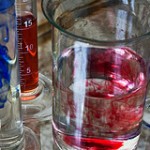Superheroes Want To Rescue Florida Science Education
Editor’s note: This post was written by WUSF’s Mark Schreiner.
Sam DuPont and Audrey Buttice were once mild-mannered USF Ph.D. students.
As part of a National Science Foundation-funded fellowship program, they’d visit elementary schools around the Tampa area and do science demonstrations. But they thought that they could reach more students by videotaping their work—they just needed a hook.
DuPont says they found their answer while waiting in line at Disney World.
“At first we’re like, ‘Pirates!’ and we’re like, ‘Nah, that’s not good.’ Then we’re like, ‘Clowns!’ and we’re like, ‘Ah, that’s a little too juvenile,’ and then we were like, ‘Ah, I got it, superheroes!’ and from there, that’s history!”
So, along with classmate Robert Bair, they came up with new alter egos and a back story–a lab accident that transformed them from normal scientists to super-powered members of The Scientific League of Superheroes.
DuPont became MegaByte, part-android with a computer in his brain, giving him enhanced intelligence and strength. Buttice became Sublimation, with the ability to change from a corporal form into a gaseous one, enabling her to sneak into small spaces or under doors, as well as disappear. And Bair became Superconductor, taking on the ability to conduct heat and electricity.
While they fight villains like Big Bang, Maelstrom and their archenemy, Dr. Entropy, Buttice says their real mission is getting students to love science.
“As somebody who likes science, I’ll watch the most boring science video ever,” she admits, “but if I don’t love science, what makes me watch something that I can grow and learn as a scientist, so we thought that superhero is something that can engage and pull those students in.”
Bair adds that the dual roles they play—scientist and superhero—increases the chances students will be drawn in.
“It’s kind of interesting because some kids really relate to the superheroes and some of the kids love the scientist, and so we get a good mix between the students.”
Working with very limited assistance and resources, the trio is producing a series of 20-plus minute long Superhero Training Network videos. While the episodes are heavy on comic book effects and storyline, DuPont says the most important thing is getting the science right.
“We follow the Hillsborough County School curriculum very closely,” DuPont said. “That’s what we feel’s very important so that teachers actually can use our videos in the classroom without kind of getting off track with what they actually need to accomplish with the students.”
And beyond science, Bair says they focus on the other components of STEM education—technology, engineering and math.
“Because most kids love building things, but then, when it comes to math, they hate it, and they don’t view those things as essential, which, now as a grad student, I know it’s essential.”
The Superheroes also continue to make in-class visits to the four Hillsborough County schools currently using the videos. We caught up with them as they visited fifth graders at Maniscalco Elementary School in Lutz.
The hour long presentation is fast-paced, with a lot of questions for the students, as well as two separate hands-on experiments.
“When you perform an experiment, and you see the results of your activity, that is by far one of the best learning experiments,” according to DuPont. “All a teacher or a trainer can do is to help guide the students to getting to that point where they’re doing things with their own hands.”
The students also enjoyed the experience, with ‘fun’ being the key component.
Parker Hertenstein: “They (the experiments) were pretty easy and they were like good instructors, it was very simple and it was very fun to actually do the things.”
Madeline Macaluso: “It was fun to get the hands-on learning experience and just be able to kind of do it yourself to make you seem like a real scientist.”
The League’s work is paying off. According to Maniscalco 5th grade teacher Michelle Clinton, the students’ test scores improved after only a few visits from the superheroes.
“We took our mid-year assessment in December, we noticed a huge, huge jump in our students’ knowledge data-wise in conductors and insulators for example, and that was one of the main things that they did when they came out in October.”
The Scientific League of Superheroes is going to try to expand the program beyond the four schools they currently visit, and maybe even add 3rd, 4th and 6th grade levels–ages that many STEM programs don’t currently reach, despite the fact that it’s the ideal time to engage young students. Buttice says they’d also like to conduct a pilot study on the program’s effectiveness next school year. And beyond that?
“We’re hoping to create a video series that can be utilized in elementary schools everywhere, Florida, the nation, however far we can get it,” Buttice says with a laugh.
However, there’s a bit of Kryptonite that’s sapping the strength of these superheroes right now: that National Science Foundation grant that funds their work runs out later this summer.
But DuPont says that’s not going to change their mission of helping young people realize that there’s a world of knowledge just waiting for them to discover it.
“It feels great to see the excitement in the students’ eyes. When they start looking at what we do and say, ‘I want to do what you do when I grow up,’ that makes, that’s all the reward I could ever ask for.”


